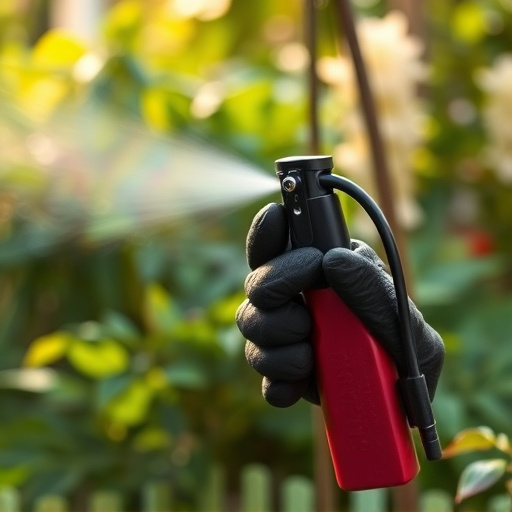Pepper spray is a powerful law enforcement tool to be used strategically as a last resort when de-escalation efforts fail or an individual poses an imminent threat. Officers, through proper training, learn to assess situations accurately, ensuring safe and effective use of capsaicin which causes temporary blindness, tearing, coughing, and breathing difficulties. Correct usage enables quick suspect subduing, enhancing officer safety during control and arrest processes. Safe deployment requires understanding pepper spray's purpose, limitations, and handling techniques, considering distance, environment, potential harm, and individual sensitivity, especially in vulnerable conditions or hot environments. Training should include proper application techniques, safety precautions, legal considerations, and documentation procedures to mitigate risks and protect all involved parties.
“In the realm of law enforcement, pepper spray serves as a versatile non-lethal weapon, offering a crucial tool for officers facing volatile situations. This article delves into the intricacies of using pepper spray effectively and safely. From understanding its chemical composition to recognizing appropriate deployment scenarios, we explore best practices and potential risks. Learn about handling techniques, legal considerations, and training requirements to ensure its responsible use. Discover the key to deploying pepper spray when it matters most – safely.”
- Understanding Pepper Spray: A Law Enforcement Tool
- When is it Appropriate to Deploy Pepper Spray?
- Safe Handling and Deployment Techniques
- Potential Risks and Side Effects
- Legal Considerations and Training Requirements
Understanding Pepper Spray: A Law Enforcement Tool
Pepper spray, an essential tool in law enforcement’s arsenal, is a chemical agent designed to incapacitate individuals temporarily. When deployed safely and appropriately, it can provide officers with crucial time to control and de-escalate potentially dangerous situations. The active ingredient, capsaicin, triggers a burning sensation in the eyes, nose, and throat, leading to temporary blindness, tears, coughing, and difficulty breathing.
Understanding when and how to use pepper spray safely is paramount for law enforcement officers. It should be employed as a last resort when other de-escalation techniques fail or when an individual poses a significant threat. Proper training ensures officers can accurately assess situations, minimizing the risk of excessive force and ensuring public safety. When used correctly, pepper spray can quickly subdue suspects, allowing for safer control and arrest.
When is it Appropriate to Deploy Pepper Spray?
When is it appropriate to deploy pepper spray? In law enforcement, pepper spray is a non-lethal weapon used as a last resort when other de-escalation tactics have failed or when officers face an imminent threat of serious bodily harm. It’s crucial for officers to consider the situation’s context and ensure the use of force is proportional to the perceived danger. Using pepper spray safely involves assessing the subject’s behavior, surrounding environment, and potential for causing harm to bystanders.
Officers should only deploy pepper spray when necessary to control an active assailant or to protect themselves or others from imminent physical harm. Situations like a suspect resisting arrest, attacking officers with a weapon, or endangering innocent people make it appropriate to use pepper spray as a means of de-escalation and crowd control. Proper training and adherence to department protocols are essential to ensure the safe and effective use of this powerful tool.
Safe Handling and Deployment Techniques
When to Use Pepper Spray Safely begins with understanding its purpose and limitations. Law enforcement officers should be trained in safe handling techniques, ensuring they deploy pepper spray only as a last resort when other de-escalation methods have failed. It’s crucial to assess the situation, considering factors like distance, environment, and potential for harm to bystanders or colleagues.
Proper deployment involves aiming at the face, eyes, and nose, creating an obstacle between the user and the target. Training should emphasize accuracy over excessive use, as misaimed spray can cause collateral damage or fail to subdue the subject effectively. Regular practice in controlled settings helps officers develop confidence and proficiency, ensuring they employ pepper spray safely and responsibly.
Potential Risks and Side Effects
When to Use Pepper Spray Safely
While pepper spray can be a powerful tool for law enforcement, it’s crucial to understand its potential risks and side effects. When used improperly or in unsuitable conditions, pepper spray can lead to adverse reactions, especially in individuals with respiratory conditions, asthma, or sensitive skin. These risks include difficulty breathing, eye irritation, dizziness, nausea, and even temporary blindness. It’s essential for officers to receive adequate training on its safe deployment, including recognizing when it’s appropriate to use such force and understanding the limitations of the spray.
The side effects can vary widely based on factors like the concentration of capsaicin (the active ingredient), weather conditions, and individual sensitivity. In hot environments or during physical exertion, the effects of pepper spray can be amplified. Therefore, law enforcement agencies must provide clear guidelines on when and how to deploy it safely, ensuring that officers are prepared for potential health impacts and that citizens are protected from unnecessary harm.
Legal Considerations and Training Requirements
Law enforcement grade pepper spray is a powerful tool that, when used safely and appropriately, can quickly de-escalate volatile situations. However, its deployment comes with stringent legal considerations and training requirements. Officers must be trained to understand when to use pepper spray as a last resort, ensuring it’s only employed when necessary to control or subdue an individual who poses an imminent threat.
Training should cover proper application techniques, safety precautions, and the potential consequences of misuse. This includes knowledge of state and local laws regarding its use, consent issues, and how to document and justify each instance of pepper spray deployment to protect both officers and those affected from potential legal repercussions.
Pepper spray, when used appropriately and safely, can be a powerful tool for law enforcement. Understanding its mechanics, deployment techniques, and potential risks is crucial. By adhering to legal considerations and undergoing proper training, officers can effectively utilize pepper spray as a last resort to control and de-escalate dangerous situations. Knowing when to deploy it responsibly ensures public safety while minimizing harm.
